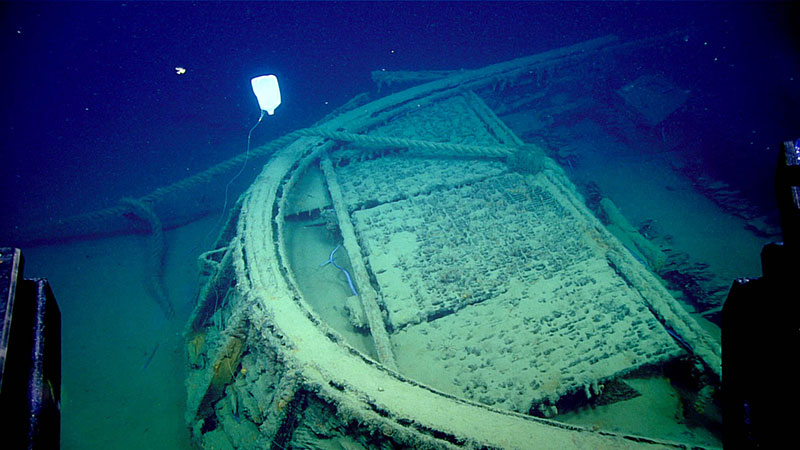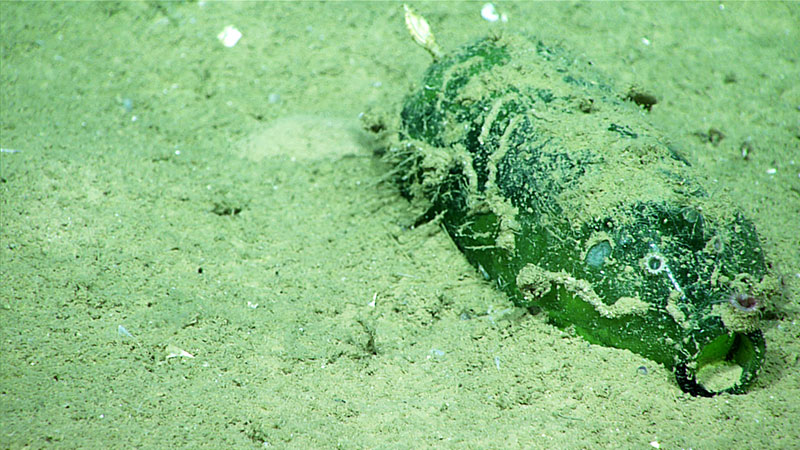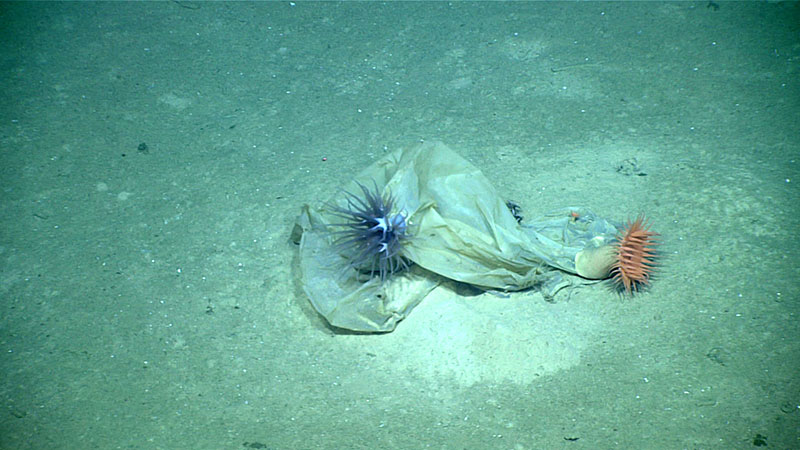
by Amy Bowman, NOAA Office of Ocean Exploration and Research
April 18, 2018

On Dive 01, there was what appeared to be a plastic milk or juice container that had become attached to the shipwreck. Image courtesy of the NOAA Office of Ocean Exploration and Research, Gulf of Mexico 2018. Download larger version (jpg, 658 KB).
Off in the far distance, an object began to appear on the live stream video, it was hard to tell what it was. The remotely operated vehicle (ROV) pilots were finishing their final checks.
“We see what looks like our first rock, perhaps with a flytrap anemone, it’s hard to see from this distance,” biology science lead Daniel Wagner noted.
The camera zoomed in. “Trash?” asked the ROV team.
As the camera came into focus, Adam Skarke agreed, “And as we zoom here, it looks like we’ve got some anemones on a man-made object, perhaps a plastic bag, on the seafloor.”
Sure enough, it was a plastic bag, and there were several anemones on it. We were nearly 1,600 meters (~5,250 feet) deep, over 275 kilometers (~170 miles) from shore, and one of the first things we found on Dive 03 was garbage. Thankfully it wasn’t the only thing we saw, there were many beautiful and interesting marine organisms throughout the dive. However, this sighting did bring up an important issue.

On Dive 02, a glass bottle was observed near the shipwreck we surveyed. Image courtesy of the NOAA Office of Ocean Exploration and Research, Gulf of Mexico 2018. Download larger version (jpg, 1.2 MB).
In the ocean, one of the many detrimental environmental problems is marine debris. Marine debris is defined as any persistent solid material that is manufactured or processed and directly or indirectly, intentionally or unintentionally, disposed of or abandoned into the marine environment or the Great Lakes. You may wonder what this has to do with NOAA Ship Okeanos Explorer, since we work exclusively in the remote deep sea. Unfortunately, there is no part of the world left untouched by debris and its impacts – marine debris has even managed to find its way to the deepest part of the ocean, the Mariana Trench, where we found garbage thousands of meters down two years ago.
Marine debris has many negative impacts. Marine animals often become entangled in or eat marine debris, which can be fatal. Marine debris can damage important habitat for marine animals, where debris can break, smother, and otherwise destroy sensitive ecosystems. It can even bring invasive species to new regions. Additionally, people can incur economic costs from marine debris – like coastal communities that have to pay to clean their shorelines and boaters whose vessels and engines can be damaged by marine debris.
While some may think that the most of the trash in our oceans comes from people dumping garbage at sea, that is not the case. The International Maritime Organization’s International Convention for the Prevention of Marine Pollution from Ships (MARPOL) Annex V has been regulating garbage disposal at sea since 1988. It is currently prohibited to discharge almost any garbage at sea; exceptions include food and limited liquids (like the fresh water used to rinse salt water from ROV Deep Discoverer after a dive). Garbage frequently makes its way into the water from land, even from areas that are far inland. Rivers and streams can carry garbage for thousands of miles and deposit it into the ocean, where ocean currents and wind can carry debris far out to sea.

When we reached the bottom at nearly 1,600 meters (~5,250 feet) on Dive 03, one of the first things we observed was a plastic bag with anemones on it. Image courtesy of the NOAA Office of Ocean Exploration and Research, Gulf of Mexico 2018. Download larger version (jpg, 1.0 MB).
As shown in the photos above, we observed marine debris during each of the first three dives of this expedition.
But don’t despair – we can all do something to help with this problem! Many communities have opportunities for beach and watershed cleanups. Many not-for-profit groups (e.g., Oceana, Surfrider, and Ocean Conservancy) have information about these opportunities on their websites. These are fun activities held outdoors with other civic-minded folks who care about the environment. Additionally, we can all dispose of our trash properly, which reduces marine debris by preventing trash from entering our ocean, waterways, and Great Lakes. We should also be mindful of the 3 R’s: reduce, reuse, and recycle. To learn more about the issue of marine debris and what you can do to help, please visit the NOAA Marine Debris Program’s website: https://marinedebris.noaa.gov/.